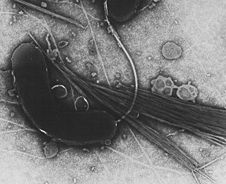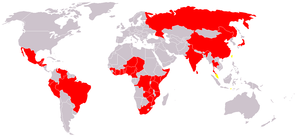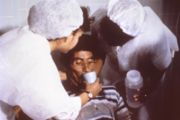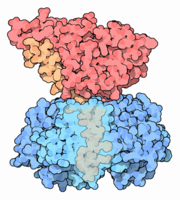Cholera
2008/9 Schools Wikipedia Selection. Related subjects: Health and medicine
| Cholera Classification and external resources |
|
| TEM image of Vibrio cholerae | |
| ICD- 10 | A 00., |
Cholera, sometimes known as Asiatic cholera or epidemic cholera, is an infectious gastroenteritis caused by the bacterium Vibrio cholerae. Transmission to humans occurs through ingesting contaminated water or food. The major reservoir for cholera was long assumed to be humans themselves, but considerable evidence exists that aquatic environments can serve as reservoirs of the bacteria.
Vibrio cholerae is a Gram-negative bacterium that produces cholera toxin, an enterotoxin, whose action on the mucosal epithelium lining of the small intestine is responsible for the characteristic massive diarrhoea of the disease. In its most severe forms, cholera is one of the most rapidly fatal illnesses known, and a healthy person may become hypotensive within an hour of the onset of symptoms; infected patients may die within three hours if treatment is not provided. In a common scenario, the disease progresses from the first liquid stool to shock in 4 to 12 hours, with death following in 18 hours to several days without oral rehydration therapy.
Symptoms
The diarrhea associated with cholera is acute and so severe that, unless oral rehydration therapy is started promptly, the diarrhea may within hours result in severe dehydration (a medical emergency), or even death.
According to novelist Susan Sontag, cholera was more feared than some other deadly diseases because it dehumanized the victim. Diarrhea and dehydration were so severe the victim could literally shrink into a wizened caricature of his or her former self before death.
Other symptoms include rapid dehydration, rapid pulse, dry skin, tiredness, abdominal cramps, nausea, and vomiting.
Traditionally, Cholera was widespread throughout third world countries, however more recently outbreaks have occurred in more rural parts of England and the United States' mid-west region.
Treatment
Water and electrolyte replacement are essential treatments for cholera, as dehydration and electrolyte depletion occur rapidly. Prompt use of oral rehydration therapy is highly effective, safe, uncomplicated, and inexpensive.
The use of intravenous rehydration may be absolutely necessary in severe cases, under some conditions.
In addition, tetracycline is typically used as the primary antibiotic, although some strains of V. cholerae exist that have shown resistance. Other antibiotics that have been proven effective against V. cholerae include cotrimoxazole, erythromycin, doxycycline, chloramphenicol, and furazolidone. Fluoroquinolones such as norfloxacin also may be used, but resistance has been reported.
Rapid diagnostic assay methods are available for the identification of multidrug resistant V. cholerae. New generation antimicrobials have been discovered which are effective against V. cholerae in in vitro studies.
Epidemiology
Prevention
Although cholera can be life-threatening, prevention of the disease is straightforward if proper sanitation practices are followed. In the first world, due to advanced water treatment and sanitation systems, cholera is no longer a major health threat. The last major outbreak of cholera in the United States occurred in 1911. Travelers should be aware of how the disease is transmitted and what can be done to prevent it. Good sanitation practices, if instituted in time, are usually sufficient to stop an epidemic. There are several points along the transmission path at which the spread may be halted:
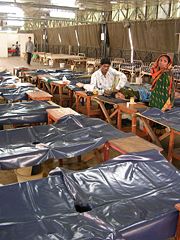
- Sterilization: Proper disposal and treatment of the germ infected fecal waste (and all clothing and bedding that come in contact with it) produced by cholera victims is of primary importance. All materials (such as clothing and bedding) that come in contact with cholera patients should be sterilized in hot water using chlorine bleach if possible. Hands that touch cholera patients or their clothing and bedding should be thoroughly cleaned and sterilized.
- Sewage: Treatment of general sewage before it enters the waterways or underground water supplies prevents undiagnosed patients from spreading the disease.
- Sources: Warnings about cholera contamination posted around contaminated water sources with directions on how to decontaminate the water.
- Water purification: All water used for drinking, washing, or cooking should be sterilized by boiling or chlorination in any area where cholera may be present. Boiling, filtering, and chlorination of water kill the bacteria produced by cholera patients and prevent infections from spreading. Water filtration, chlorination, and boiling are by far the most effective means of halting transmission. Cloth filters, though very basic, have significantly reduced the occurrence of cholera when used in poor villages in Bangladesh that rely on untreated surface water. Public health education and appropriate sanitation practices can help prevent transmission.
A vaccine is available outside the US, but this prophylactic is short-lived in efficacy and not currently recommended by the CDC.
Susceptibility
Recent epidemiologic research suggests that an individual's susceptibility to cholera (and other diarrhoeal infections) is affected by their blood type: Those with type O blood are the most susceptible, while those with type AB are the most resistant. Between these two extremes are the A and B blood types, with type A being more resistant than type B.
About one million V. cholerae bacteria must typically be ingested to cause cholera in normally healthy adults, although increased susceptibility may be observed in those with a weakened immune system, individuals with decreased gastric acidity (as from the use of antacids), or those who are malnourished.
It has also been hypothesized that the cystic fibrosis genetic mutation has been maintained in humans due to a selective advantage: heterozygous carriers of the mutation (who are thus not affected by cystic fibrosis) are more resistant to V. cholerae infections. In this model, the genetic deficiency in the cystic fibrosis transmembrane conductance regulator channel proteins interferes with bacteria binding to the gastrointestinal epithelium, thus reducing the effects of an infection.
Transmission
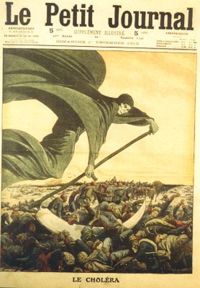
Persons infected with cholera have massive diarrhoea. This highly-liquid diarrhoea is loaded with bacteria that can spread to infect water used by other people. Cholera is transmitted from person to person through ingestion of water contaminated with the cholera bacterium, usually from feces or other effluent. The source of the contamination is typically other cholera patients when their untreated diarrhoea discharge is allowed to get into waterways or into groundwater or drinking water supply. Any infected water and any foods washed in the water, as well as shellfish living in the affected waterway, can cause an infection. Cholera is rarely spread directly from person to person. V. cholerae harbors naturally in the plankton of fresh, brackish, and salt water, attached primarily to copepods in the zooplankton. Both toxic and non-toxic strains exist. Non-toxic strains can acquire toxicity through a lysogenic bacteriophage. Coastal cholera outbreaks typically follow zooplankton blooms, thus making cholera a zoonotic disease.
Laboratory diagnosis
Stool and swab samples collected in the acute stage of the disease, before antibiotics have been administered, are the most useful specimens for laboratory diagnosis. A number of special media have been employed for the cultivation for cholera vibrios. They are classified as follows:
Biochemistry of the V. cholerae bacterium
Most of the V. cholerae bacteria in the contaminated water that a host drinks do not survive the very acidic conditions of the human stomach. The few bacteria that do survive conserve their energy and stored nutrients during the passage through the stomach by shutting down much protein production. When the surviving bacteria exit the stomach and reach the small intestine, they need to propel themselves through the thick mucus that lines the small intestine to get to the intestinal wall where they can thrive. V. cholerae bacteria start up production of the hollow cylindrical protein flagellin to make flagella, the curly whip-like tails that they rotate to propel themselves through the mucous that lines the small intestine.
Once the cholera bacteria reach the intestinal wall, they do not need the flagella propellers to move themselves any longer. The bacteria stop producing the protein flagellin, thus again conserving energy and nutrients by changing the mix of proteins that they manufacture in response to the changed chemical surroundings. On reaching the intestinal wall, V. cholerae start producing the toxic proteins that give the infected person a watery diarrhoea. This carries the multiplying new generations of V. cholerae bacteria out into the drinking water of the next host—if proper sanitation measures are not in place.
Microbiologists have studied the genetic mechanisms by which the V. cholerae bacteria turn off the production of some proteins and turn on the production of other proteins as they respond to the series of chemical environments they encounter, passing through the stomach, through the mucous layer of the small intestine, and on to the intestinal wall. Of particular interest have been the genetic mechanisms by which cholera bacteria turn on the protein production of the toxins that interact with host cell mechanisms to pump chloride ions into the small intestine, creating an ionic pressure which prevents sodium ions from entering the cell. The chloride and sodium ions create a salt water environment in the small intestines which through osmosis can pull up to six liters of water per day through the intestinal cells creating the massive amounts of diarrhoea.The host can become rapidly dehydrated if an appropriate mixture of dilute salt water and sugar is not taken to replace the blood's water and salts lost in the diarrhoea.
By inserting separately, successive sections of V. cholerae DNA into the DNA of other bacteria such as E. coli that would not naturally produce the protein toxins, researchers have investigated the mechanisms by which V. cholerae responds to the changing chemical environments of the stomach, mucous layers, and intestinal wall. Researchers have discovered that there is a complex cascade of regulatory proteins that control expression of V. cholerae virulence determinants. In responding to the chemical environment at the intestinal wall, the V. cholerae bacteria produce the TcpP/TcpH proteins, which, together with the ToxR/ToxS proteins, activate the expression of the ToxT regulatory protein. ToxT then directly activates expression of virulence genes that produce the toxins that cause diarrhoea in the infected person and that permit the bacteria to colonize the intestine. Current research aims at discovering "the signal that makes the cholera bacteria stop swimming and start to colonize (that is, adhere to the cells of) the small intestine."
History
Origin and spread
Cholera was originally endemic to the Indian subcontinent, with the Ganges River likely serving as a contamination reservoir. The disease spread by trade routes (land and sea) to Russia, then to Western Europe, and from Europe to North America. Cholera is now no longer considered a pressing health threat in Europe and North America due to filtering and chlorination of water supplies, but affects heavily the developing countries populations.
- 1816-1826 - First cholera pandemic: Previously restricted, the pandemic began in Bengal, and then spread across India by 1820. The cholera outbreak extended as far as China and the Caspian Sea before receding.
- 1829-1851 - Second cholera pandemic reached Europe, London and Paris in 1832. In London, the disease claimed 6,536 victims; in Paris, 20,000 succumbed (out of a population of 650,000) with about 100,000 deaths in all of France. The epidemic reached Russia (see Cholera Riots), Quebec, Ontario and New York in the same year and the Pacific coast of North America by 1834.
- 1849 - Second major outbreak in Paris. In London, it was the worst outbreak in the city's history, claiming 14,137 lives, over twice as many as the 1832 outbreak. In 1849 cholera claimed 5,308 lives in the port city of Liverpool, England, and 1,834 in Hull, England. An outbreak in North America took the life of former U.S. President James K. Polk. Cholera spread throughout the Mississippi river system killing over 4,500 in St. Louis and over 3,000 in New Orleans as well as thousands in New York. In 1849 cholera was spread along the California and Oregon trail as hundreds died on their way to the California Gold Rush, Utah and Oregon.
- 1852-1860 - Third cholera pandemic mainly affected Russia, with over a million deaths. In 1853-4, London's epidemic claimed 10,738 lives.
- 1854 - Outbreak of cholera in Chicago took the lives of 5.5% of the population (about 3,500 people). The Soho outbreak in London ended after removal of the handle of the Broad Street pump by a committee instigated to action by John Snow.
- 1863-1875 - Fourth cholera pandemic spread mostly in Europe and Africa.
- 1866 - Outbreak in North America. In London, a localized epidemic in the East End claimed 5,596 lives just as London was completing its major sewage and water treatment systems--the East End was not quite complete. William Farr, using the work of John Snow et al. as to contaminated drinking water being the likely source of the disease, was able to relatively quickly identify the East London Water Company as the source of the contaminated water. Quick action prevented further deaths. Also a minor outbreak at Ystalyfera in South Wales. Caused by the local water works using contaminated canal water, it was mainly its workers and their families who suffered. Only 119 died.

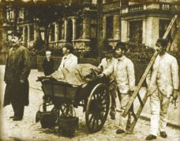
- 1881-1896 - Fifth cholera pandemic ; The 1892 outbreak in Hamburg, Germany was the only major European outbreak; about 8,600 people died in Hamburg. Although generally held responsible for the virulence of the epidemic, the city government went largely unchanged. This was the last serious European cholera outbreak.
- 1899-1923 - Sixth cholera pandemic had little effect in Europe because of advances in public health, but major Russian cities were particularly hard hit by cholera deaths.
- 1961-1970s - Seventh cholera pandemic began in Indonesia, called El Tor after the strain, and reached Bangladesh in 1963, India in 1964, and the USSR in 1966. From North Africa it spread into Italy by 1973. In the late 1970s, there were small outbreaks in Japan and in the South Pacific. There were also many reports of a cholera outbreak near Baku in 1972, but information about it was suppressed in the USSR.
- January 1991 to September 1994 - Outbreak in South America, apparently initiated when a ship discharged ballast water. Beginning in Peru there were 1.04 million identified cases and almost 10,000 deaths. The causative agent was an O1, El Tor strain, with small differences from the seventh pandemic strain. In 1992 a new strain appeared in Asia, a non-O1, nonagglutinable vibrio (NAG) named O139 Bengal. It was first identified in Tamil Nadu, India and for a while displaced El Tor in southern Asia before decreasing in prevalence from 1995 to around 10% of all cases. It is considered to be an intermediate between El Tor and the classic strain and occurs in a new serogroup. There is evidence of the emergence of wide-spectrum resistance to drugs such as trimethoprim, sulfamethoxazole and streptomycin.
Famous cholera victims
The pathos in the last movement of Tchaikovsky's (c. 1840-1893) last symphony made people think that Tchaikovsky had a premonition of death. "A week after the premiere of his Sixth Symphony, Tchaikovsky was dead--6 November 1893. The cause of this indisposition and stomach ache was suspected to be his intentionally infecting himself with cholera by drinking contaminated water. The day before, while having lunch with Modest (his brother and biographer), he is said to have poured tap water from a pitcher into his glass and drunk a few swallows. Since the water was not boiled and cholera was once again rampaging St. Petersburg, such a connection was quite plausible ...."
Other famous people who succumbed to the disease include:
- Major General Edward Hand, Adjutant General of the Continental Army and congressman
- James K. Polk, eleventh president of the United States
- Mary Abigail Fillmore, daughter of U.S. president Millard Fillmore
- Elizabeth Jackson, mother of U.S. president Andrew Jackson
- Elliott Frost, son of American poet Robert Frost
- Nicolas Léonard Sadi Carnot
- Georg Wilhelm Friedrich Hegel
- Samuel Charles Stowe, son of Harriet Beecher Stowe
- Carl von Clausewitz
- George Bradshaw
- Adam Mickiewicz
- August von Gneisenau
- William Jenkins Worth
- John Blake Dillon
- Daniel Morgan Boone, founder of Kansas City, Missouri, son of Daniel Boone
- James Clarence Mangan
- Mohammad Ali Mirza Dowlatshahi of Persia
- Ando Hiroshige, Japanese ukiyo-e woodblock print artist.
- Juan de Veramendi, Mexican Governor of Texas, father-in-law of Jim Bowie
- Grand Duke Constantine Pavlovich of Russia
- William Shelley, son of Mary Shelley
- William Godwin, father of Mary Shelley
- Judge Daniel Stanton Bacon, father-in-law of George Armstrong Custer
- Inessa Armand, mistress of Lenin and the mother of Andre, his son.
- Honinbo Shusaku, famous go player.
- Henry Louis Vivian Derozio, Eurasian Portuguese Poet and Teacher. Resided in India.
- Alexandre Dumas, père, French author of The Three Musketeers and The Count of Monte Cristo, also contracted cholera in the 1832 Paris epidemic and almost died, before he wrote these two novels.
- Charles X of France
Research
One of the major contributions to fighting cholera was made by physician and self-trained scientist John Snow (1813-1858), who found the link between cholera and contaminated drinking water in 1854. In addition, Henry Whitehead, an Anglican minister, helped Snow track down and verify the source of the disease, which turned out to be an infected well in London. Their conclusions were widely distributed and firmly established for the first time a definite link between germs and disease. Clean water and good sewage treatment, despite their major engineering and financial cost, slowly became a priority throughout the major developed cities in the world from this time onward. Robert Koch, 30 years later, identified V. cholerae with a microscope as the bacillus causing the disease in 1885. The bacterium had been originally isolated thirty years earlier (1855) by Italian anatomist Filippo Pacini, but its exact nature and his results were not widely known around the world. The Spanish doctor Jaume Ferran i Clua developed the first cholera vaccine in 1885.
Cholera has been a laboratory for the study of evolution of virulence. The province of Bengal in British India was partitioned into West Bengal and East Pakistan in 1947. Prior to partition, both regions had cholera pathogens with similar characteristics. After 1947, India made more progress on public health than East Pakistan (now Bangladesh). As a consequence, the strains of the pathogen that succeeded in India had a greater incentive in the longevity of the host and are less virulent than the strains prevailing in Bangladesh, which uninhibitedly draw upon the resources of the host population, thus rapidly killing many victims.
False historical report of cholera
A persistent myth states that 90,000 people died in Chicago of cholera and typhoid fever in 1885, but this story has no factual basis. In 1885, there was a torrential rainstorm that flushed the Chicago river and its attendant pollutants into Lake Michigan far enough that the city's water supply was contaminated. However, because cholera was not present in the city, there were no cholera-related deaths, though the incident caused the city to become more serious about its sewage treatment.
Cholera morbus
The term cholera morbus was used in the 19th and early 20th centuries to describe both non-epidemic cholera and other gastrointestinal diseases (sometimes epidemic) that resembled cholera. The term is not in current use, but is found in many older references. The other diseases are now known collectively as gastroenteritis.
Other historical information
In the past, people traveling in ships would hang a yellow flag if one or more of the crew members suffered from cholera. Boats with a yellow flag hung would not be allowed to disembark at any harbour for an extended period, typically 30 to 40 days.
